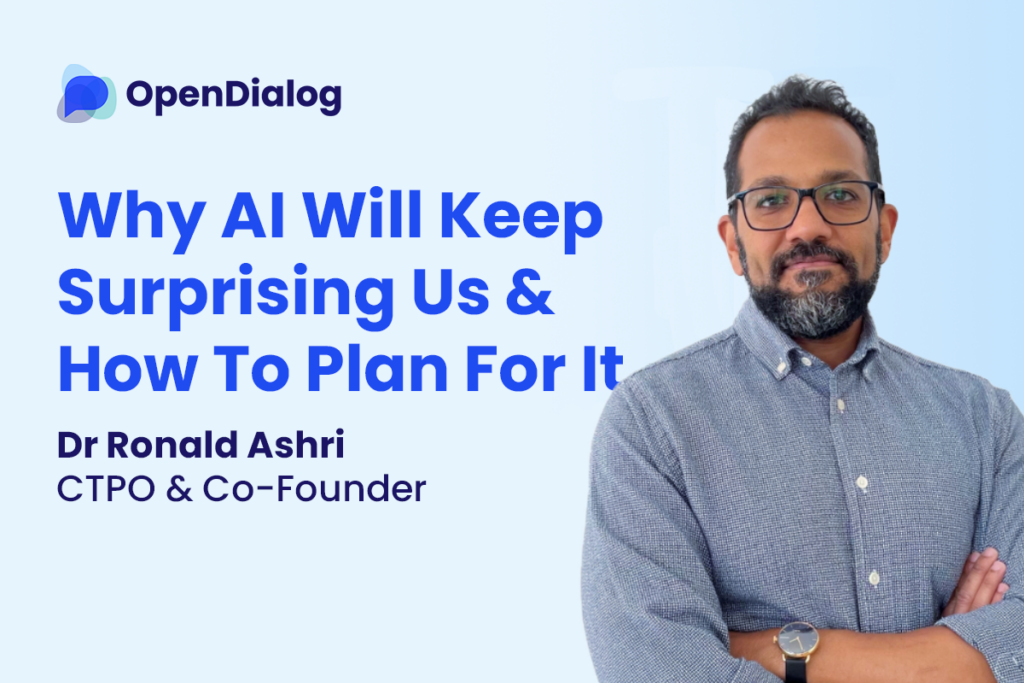The exponential rate of growth of AI capabilities, their deep integration in everyday tooling, and the massive levels of investment will lead to an explosion of AI-powered solutions. We’ve never had to go through such a rapid growth in automation capabilities. Especially as it directly impacts a space that we considered (and still consider) primarily knowledge work that only humans could do. Inevitably, planning for such change will be harder and requires approaches that take this reality explicitly into account. Here I explain why I think AI will keep surprising us, and how we can plan for it.
Why AI will keep surprising us
In 2017, I stood up in front of an audience of web developers and gave a talk titled ‘An AI bot will build and run your next site… eventually’. I spoke about the amazing achievements of AI and the first signs of services that automated aspects of web design from content creation to logo design. However, I didn’t really believe that a bot would completely build and run a website. The services at the time were interesting but not true replacements to content writers or designers. I knew I logically had to believe we would (eventually) get there because evidence pointed that way, but the emotional side of my brain did not allow me to fully embrace the change. It was hard to see how exactly we would get there and there was a level of concern about the consequences. Fast forward to 2023 and here we are – and the pace is accelerating.
That is why I keep reminding myself that when change does happen it will always surprise us. There are two “forces” or (unscientific) laws of technology that seem to determine this. Exponential change and interconnectedness.
Exponential Change
Whether it is Moore’s law for transistors or the number of parameters a large language model handles, there seems to be something that drives technology to double in capability at a constant rate. The amazing thing about doubling at a constant rate – or exponentially – is that each new doubling in capability brings far more change than multiple previous doublings. Just run the maths in your head. Start with 1, double to 2, then make it 4, 8, 16, 32, 64, 128, 512, 1024, etc. Just a few more steps and you will be in the millions, and before you know it, the billions! We humans have a really hard time dealing with such rapid change and we are now several steps into the doubling of AI capability. This is why I think technological change will keep surprising us – because the next step will be larger than several previous steps.
Interconnectedness
Together with exponential rate of change, we have the multiplier effect of interconnectedness. This is the aggregate effect of multiple developments happening at the same time. For example, the current explosion in machine learning capabilities was the result of advances in parallel processing (using cheap GPUs instead of expensive specialised processors), the aggregation of data and better algorithms. We will see many more such examples at a higher pace as technological capabilities mix and match and huge investment goes into generative AI to build foundational models and products on top of those models.
Despite what my emotional side might want (a slow easy life) the logical side has to conclude that AI will keep changing and will keep surprising us the way it did when ChatGPT came out. The question then becomes, how do you plan for the future?
How to plan for AI’s next surprise
An answer can be found in systems thinking. In particular, I place a lot of emphasis on organisational and technical systems that are loosely coupled and highly cohesive. The engineers in the crowd will recognise these terms. A loosely coupled system is one where individual modules are independent. They have clearly defined interfaces but they can be thought about in isolation. Cohesive systems are ones where the various parts function together in harmony towards a single goal. Such systems tend to provide good models of the real world and what is actually going on, and allow you to design for multiple situations while remaining efficient. They are also easy to think about in the abstract but very hard to get right in practice.
An example of a tightly coupled and disjointed system could be a Conversational AI solution that depends on a single way of understanding language (say an ML classifier of user phrases) and a single way of representing a conversation (say a flow chart). Such a system will find it hard to deal with Generative AI technologies that do much more than just classify. Instead, a loosely coupled system is one that disaggregates the way to understand language from the underlying way to represent language and reason about a conversation. A loosely coupled system allows you to define multiple solutions with different types of modules that can still work in harmony.
The example is not casual. This is exactly what we do at OpenDialog AI in building a Conversational AI platform. We focused on loosely coupled components that form a cohesive understanding of the whole challenge of designing purposeful conversations. This gives us a system that can adapt and take advantage of changes to language understanding capabilities. It can also combine them coherently. The approach, however, can be extended to any system – whether it is how you organise your teams, build your software or grow an organisation.
Whether you are designing conversational AI platforms or organisational systems, keep in mind that the future will change faster than the past. Embrace that and build systems that are loosely coupled and cohesive.



